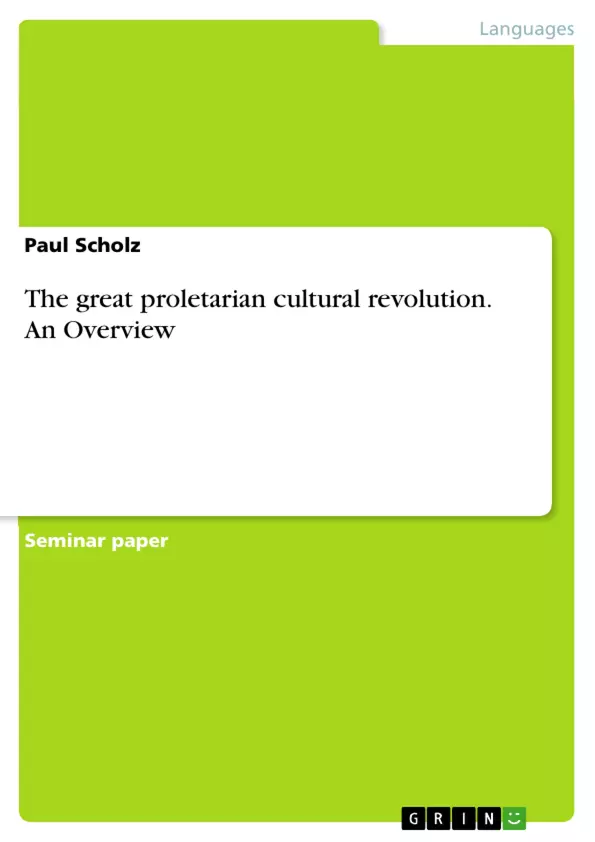The Chinese Cultural Revolution, also well known as the Great Proletarian Cultural Revolution – Wuchanjieji Wenhua Dageming, describes a unparalleled and from the top established revolution launched by Chinese Communist Party (CCP) chairman Mao Zedong during his very last period in power (1966–76) to restore the spirit of the Chinese Revolution (Lieberthal 2016).
Mao Zedong during this time feared that China possibly could develop like the Soviet Russian nation did and he did not want China to follow their example. He was very concerned about China’s and his own place in history and therefore did not hesitate to throw China’s cities into chaos in a big effort to reverse the historic processes which were on their way obviously. Plenty of the events during this period of this time are without equal in the modern world’s history. After the catastrophic Great Leap Forward, in which according to some sources more than 45 million people died, Mao Zedong decided to take a passive role in governing China. More practical and moderately oriented leaders, such as Vice-Chairman Liu Shaoqi and Premier Zhou Enlai, introduced soft economic reforms founding on individual incentives – such as allowing private people to farm their own land –an effort to rebuild and strengthen the heavily harmed economy (Leese 2016). Mao disliked such actions, as they went against the principles of pure communism in which he believed deeply. In fact, China’s economy grew sustainably from 1962 to 1965 with the more conservative economic policies applying (Stanford 2001). [...]
Inhaltsverzeichnis (Table of Contents)
- (1) Introduction.
- (2) Background
- (3) The early period (1966-1968).
- (4) Raise and fall of Lin Biau (1969-1971).
- (5) Final years (1972-1976)
- (6) Assessment...
Zielsetzung und Themenschwerpunkte (Objectives and Key Themes)
The Chinese Cultural Revolution, also known as the Great Proletarian Cultural Revolution, was a turbulent period in Chinese history initiated by Mao Zedong. This revolution aimed to reassert Mao's authority and restore the revolutionary spirit of the early communist period. The text explores the events and their impact on Chinese society.
- Mao Zedong's fear of China's potential development like the Soviet Union
- The impact of the Great Leap Forward on Mao's political standing
- The rise of the Red Guards and their role in the Cultural Revolution
- The impact of the Cultural Revolution on Chinese society and its economy
- The role of key figures like Lin Biao and Jiang Qing in the Cultural Revolution
Zusammenfassung der Kapitel (Chapter Summaries)
(1) Introduction
This chapter introduces the Chinese Cultural Revolution, outlining its origins, objectives, and context. It highlights Mao Zedong's concerns about the potential for China to follow the path of the Soviet Union and the role of the Great Leap Forward in shaping Mao's political position.
(2) Background
This chapter delves into the historical context of the Cultural Revolution, exploring Mao's concerns about the Soviet Union's reforms and the perceived decline in revolutionary fervor within China. It examines the economic and social factors that contributed to the revolution's emergence, including the Great Leap Forward and the rise of urban social stratification.
(3) The early period (1966-1968)
This chapter focuses on the initial phase of the Cultural Revolution, from its formal launch in 1966 to the period of intense social upheaval and political turmoil. It describes the formation of the Red Guards, the widespread attacks on intellectuals and traditional institutions, and the impact on China's economy.
Schlüsselwörter (Keywords)
Key terms and concepts explored in the text include Mao Zedong, Cultural Revolution, Great Proletarian Cultural Revolution, Great Leap Forward, Red Guards, Lin Biao, Jiang Qing, Soviet Union, China, communism, revolutionary spirit, and social upheaval.
- Quote paper
- Paul Scholz (Author), 2016, The great proletarian cultural revolution. An Overview, Munich, GRIN Verlag, https://www.grin.com/document/369822



